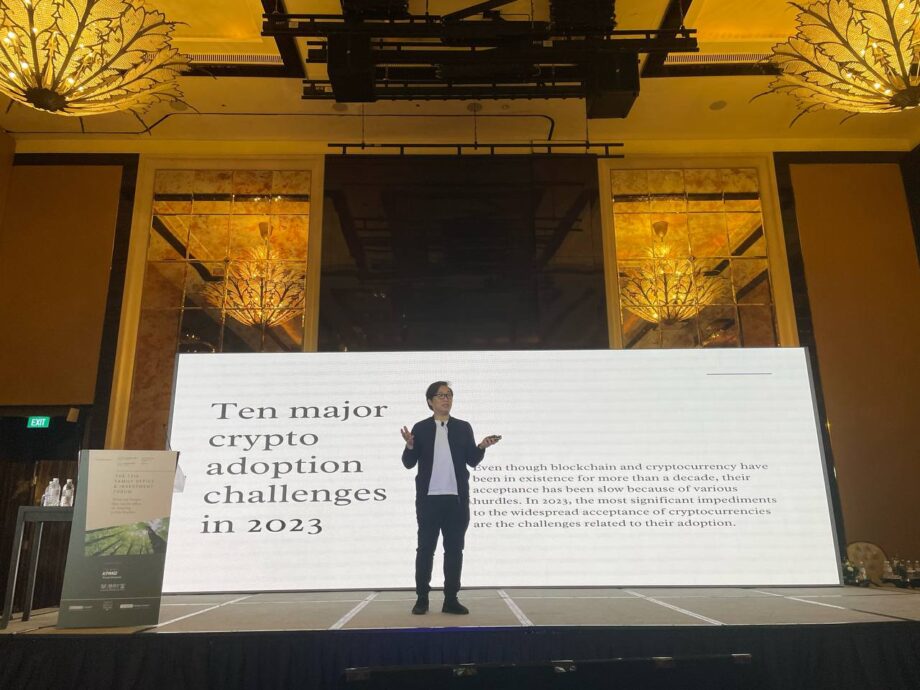Anndy Lian, intergovernmental blockchain advisor spoke at the 12th Family Office & Investment Forum in Singapore organized by Campden Club. The theme for the event is “Thrive and Prosper: How Family Office are Adapting to New Realities”.
The global pandemic has brought about a new set of challenges for family offices, which are private wealth management firms that cater to the ultra-wealthy. The economic uncertainty and market volatility have forced family offices to adapt to new realities and change their strategies to protect their clients’ wealth and ensure long-term prosperity.
One of the key ways family offices are adapting is by embracing technology. Blockchain and cryptocurrency are two topics that are widely discussed in the investment space.
Blockchain technology and cryptocurrency have been making headlines for over a decade now, and yet their widespread adoption has been slow due to various challenges. In 2023, the most significant hurdles facing the adoption of cryptocurrencies are related to their acceptance. Anndy highlighted the top ten major crypto adoption challenges in 2023 that investors should be aware of during his keynote speech.
1. Lack of Understanding of What Cryptocurrency is and How it Works.
This lack of understanding can lead to a lack of trust in the technology, which makes it difficult for people to adopt it as a means of payment or investment.
2. Volatility.
The value of cryptocurrencies can change rapidly, making it difficult for investors to make informed decisions.
3. Lack of Regulatory Frameworks.
Governments and regulatory bodies have been slow to develop policies that govern the use of cryptocurrencies, which makes investors wary of investing in them.
4. Uncertainty Regarding Taxation.
This uncertainty can discourage investors from investing in cryptocurrencies.
5. Security Risks.
Hacking and other cyberattacks can lead to the loss of cryptocurrencies, which can be devastating for investors.
6. Transaction Irreversibility.
Transactions on the blockchain are irreversible, which means that if a mistake is made, it cannot be reversed. This makes it essential for investors to be careful when making transactions.
7. Scalability Issues.
As the number of transactions on the blockchain increases, the network can become congested, leading to slow transaction times and increased fees.
8. Lack of Merchant Adoption.
Without merchants accepting cryptocurrencies as payment, it is challenging for people to use them as a means of payment.
9. Network Congestion.
It can lead to slow transaction times and increased fees. This can discourage investors from using cryptocurrencies for transactions.
10. Lack of Trust in Digital Currencies.
Finally, a lack of trust in digital currencies is a significant hurdle to their widespread adoption.
Lian also explored ten different ways to make money from cryptocurrency.
1. Crypto Saving.
Many blockchain projects and decentralized finance (DeFi) platforms offer high-interest rates for users who deposit their cryptocurrencies.
2. Protocol Tokens.
Protocol tokens are cryptocurrencies that are used to power decentralized applications (dApps) and blockchain protocols.
3. Application Tokens.
Application tokens are cryptocurrencies that are used to access and use specific dApps.
4. Staking.
Staking is a process that involves holding cryptocurrencies in a wallet to support the network’s operations.
5. Yield Farming.
Yield farming involves providing liquidity to DeFi platforms in exchange for rewards.
6. Crypto Stocks.
Several publicly traded companies offer exposure to the cryptocurrency market through their stock offerings.
7. Other Crypto Securities.
These include exchange-traded funds (ETFs), futures, and options.
8. Exchange-Traded Products.
Exchange-traded products (ETPs) are investment vehicles that allow investors to gain exposure to cryptocurrencies through their brokerage accounts.
9. Bitcoin Proxy Stocks.
Bitcoin proxy stocks are stocks of publicly traded companies that have exposure to the cryptocurrency market.
10. Web4.
Web4 is a new concept that aims to create a decentralized internet that is owned and controlled by users.
The Campden Club is a global membership organization that brings together family offices, ultra-high net worth individuals, and private investors to network, share knowledge and expertise, and discuss issues related to family wealth management and preservation. Founded in 1987, the club has over 200 member families from around the world and hosts regular events and forums to facilitate discussions on various topics, including wealth management, philanthropy, investment opportunities, family governance, and succession planning. Members of the Campden Club gain access to a network of like-minded individuals and family offices, as well as exclusive content, research, and resources related to family wealth management.

Anndy Lian is an early blockchain adopter and experienced serial entrepreneur who is known for his work in the government sector. He is a best selling book author- “NFT: From Zero to Hero” and “Blockchain Revolution 2030”.
Currently, he is appointed as the Chief Digital Advisor at Mongolia Productivity Organization, championing national digitization. Prior to his current appointments, he was the Chairman of BigONE Exchange, a global top 30 ranked crypto spot exchange and was also the Advisory Board Member for Hyundai DAC, the blockchain arm of South Korea’s largest car manufacturer Hyundai Motor Group. Lian played a pivotal role as the Blockchain Advisor for Asian Productivity Organisation (APO), an intergovernmental organization committed to improving productivity in the Asia-Pacific region.
An avid supporter of incubating start-ups, Anndy has also been a private investor for the past eight years. With a growth investment mindset, Anndy strategically demonstrates this in the companies he chooses to be involved with. He believes that what he is doing through blockchain technology currently will revolutionise and redefine traditional businesses. He also believes that the blockchain industry has to be “redecentralised”.



